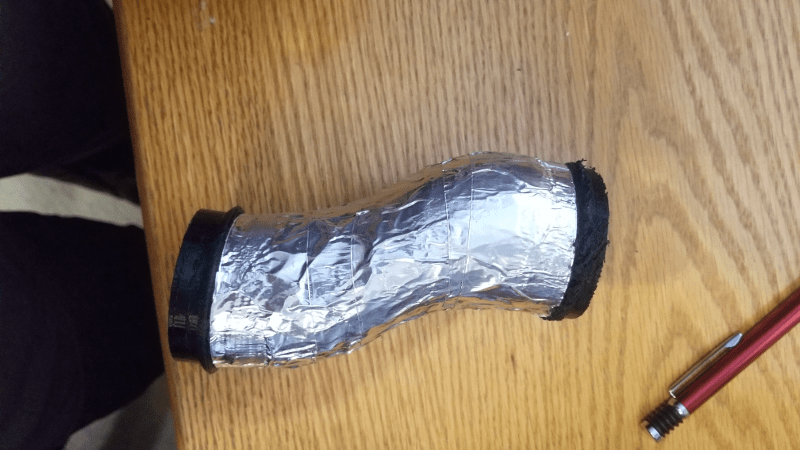[Sam] is the lucky owner of a 1990 VW Corrado G60. To the uninitiated, that’s the souped-up, go fast version with the fancy supercharger on top. While performing some mods to the air intake (car-speak for “hacks”), there came a need for a custom tube to eliminate the original silencer box. With available options costing up to $400, suddenly 3D printing a replacement seemed like a better answer.
3D printing intake parts for a supercharged vehicle has some unique challenges. The intake must be able to take the boost pressures seen by the engine, in this case up to around 10 psi. There must be no air leaks at all as this risks confusing the sensors that measure how much air is entering the engine. Lastly, the tube must be able to withstand the hot, and often oily environment under the hood.
The first attempt was completed with TPU filament, which unfortunately did not hold pressure. A followup with PLA fared better, but was unable to withstand the heat present in the engine bay. After some experimentation, a successful print was made in PETG which was more robust. In the final design, [Sam] applied a rubber coating and then some aluminum tape, to both help seal any micro-holes in the 3D printed surface as well as help protect against heat.
After over a month of testing, [Sam]’s data logs indicate the tube is performing well and holding boost. It goes to show that with some perseverance and iterative design, 3D printed parts can often save the day.
Perhaps you’re inspired by this hack but need to jack up your car to work on it? Never fear, you can 3D print those too.
















The Corrado was a cute car.
That’s probably the most extreme use for a 3D printed part I’ve seen ever. I wonder what brand of PETG got used to make the final part?
i think the best way to finish this would be to forge cast that print in aluminum
Silicone. Silicone tubing is the way to go in a vehicle. Very smooth insides for better and cleaner airflow, can withstand temperatures beyond anything you might be able to throw at it in an engine bay and can cope with loads of pressure.
Funny. I just today found out the hard way how spectacularly PETG fails at about 80C. A few degrees cooler and it’s stiff as ever. A few degrees warmer, and now you have a warm toffee noodle.
Better keep the airflow going with this mod. No stopping at red lights after a hard run — pretty easy for underhood temperatures to exceed 80C.
Or maybe the real hack is the aluminum tape that holds it all in shape until it cools down again.
Why not ABS? Seems like that would have made sense here
An alternative is only ~$230 ($140) on sale: https://bahnbrenner.com/vw_audi/products/463/RSR_G60_Outlet_Kit__The_Original_
However, props to the builder, making your own is also the route I would have taken.
Using 3d prints under the hood in this way is very silly. You don’t have to pay $400 for the tube, but you don’t have to make it out of thermoplastic either. Use reinforced dryer hose, I dunno! That thing is going to melt and suck into the damn engine.
im more amased he got to drive it fir a month without the g-ladder supercharger shitting itself. (even if your not a car person google the g-ladder design, its v unique)
Good point! I’v seen a polo g40 g ladder charge spill its guts so much so that oil was pouring out the gap between the bonnet and running down the wing. Put me right of owning one.
The G-Lader was one hell of a design failure. Hell, it even makes the rotary engine look easy to maintain.
Kudos, I’ve 3d printed things and treated them as moulds for latex style paint, but never something that saw boost, just water deflection gaiters etc.
If I was to make this tube, I’d take two tube bends and a straight length of tube in alloy and cut andnad tig the appropriate pieces together, and put a flexible section with a bead rolled lip where it slips over however, cost well under $80 for materials and gas. But I do see a lot more boost than a g-lader is capable of putting out in my toys, and I have tig and beading equipment to hand.
I have 3d printed alot of underhood pieces for the exotics we get in the shop. Ridiculous prices from the dealer, or completely unavailable parts. Normally use nylon, nylon x, or petg.
I’ve printed a few gaskets even, with ninjaflex.
Currently designing intake runners, to be printed using nylon x.
I dunno to me it looks like a solution hunting for a problem. Old style rubber automotive suppliers have reinforced hose in various sizes up to 4″
I’d be concerned with the possibility that if the part crumbles, the bits will cause some self-destruction of expensive engine parts as they get sucked into the engine. You don’t want chunks of plastic wedging valves open, shattering spark plugs, or causing the piston to hammer the valves till they bend. I second the idea of using reinforced rubber hoses!